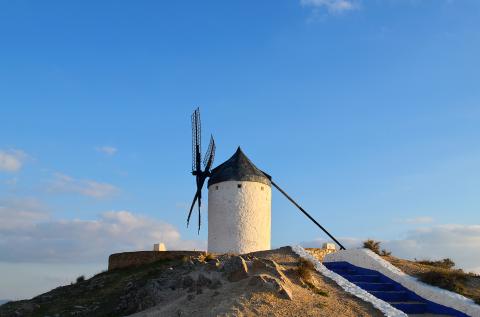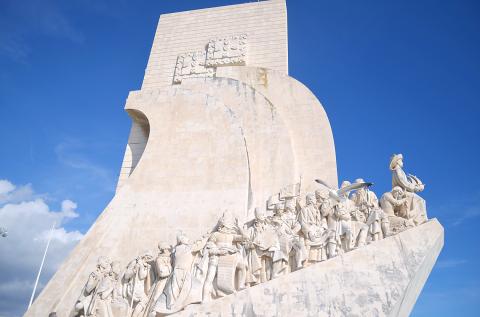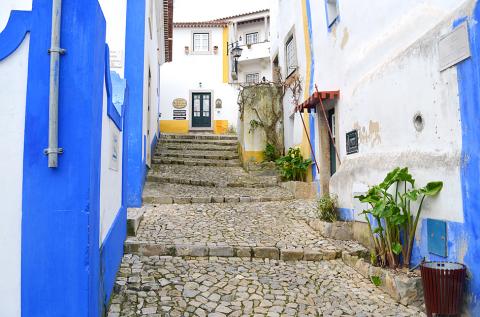Why go half way round the world to visit Spain and Portugal, the two countries that make up the Iberian Peninsula? For Taiwanese, the reasons can be many and varied. Start with the simple matter of history and destiny. After all, it was a Portuguese trade ship passing through the Taiwan Strait in 1566 that gave Taiwan its centuries-old name La Ilha Formosa, or Beautiful Island. That appellation would stick and clearly mark Taiwan on all future maps. And then there is the link made by the Spaniards who came up from the Philippines and established colonies in northern Taiwan as well.
WINDMILLS and ROYALTY
Of course, there are more traditional reasons to visit Spain and Portugal like gaining a sense of Old Europe with windmills near Madrid that remind one of Don Quixote, walking the many quaint village streets and touring the numerous castles and palaces of royalty.

Photo: Jerome Keating
For those more into the modern, there are bull fighting rings made famous in literature by fight aficionado Ernest Hemingway, as well as the land that gave birth to contemporary artists like Goya, Picasso, Miro and Dali, but which also accepted El Greco (born in Crete) as a contributor to the past Spanish Renaissance. Dance is another part of this artistic culture; who does not recognize the passion and intensity of Flamenco?
Architecture and history provide other reasons for tourism. In addition to the elaborate cathedrals found in all major cities there are also ruins from the past. The Romans occupied Spain as part of the Punic Wars with Carthage, and the later Moorish influence came across from Africa (711 AD) and clearly made its mark. In this vein, the Alhambra, the last Moorish stronghold, has long captured the imagination of writers and historians with its decorative patterns and inner courtyards expressing a totally different culture.
In the present, there is the magnificent and imaginative architecture of Antonio Gaudi found in Barcelona with La Pedrera, the Basilica of the Holy Family, and colorful Park Guell. Here is a man who bent and broke past rules to make new ones in architecture and ones more patterned after nature.

Photo: Jerome Keating
For those into political controversy, at the southern tip of Spain sits the Strait of Gibraltar and the British Overseas Territory of Gibraltar. This sticking point in the relations between Spain and the UK is the fact that since its capture in 1704, the Rock of Gibraltar, the guardian of the entrance into the Mediterranean, remains in British hands. From that location one also can easily see the coast of Africa.
And then there is the food. We are not just talking about Portuguese egg tarts — though they’ve become a popular sweet in Taiwan — but things like Tapas, and other many culinary delights that Spain and Portugal imported from the vast empires that they had set up around the world.
Except for the northeast corner, which links Spain to the continent via the Pyrenees, the Iberian Peninsula is almost an Island. It fronts the ocean on both its northern, western and southern coasts, and on the east it fronts the Mediterranean Sea. The Iberians may like their bull fighting, their Flamenco and even their soccer, but they have also never forgotten their pride in being “children of the ocean.”

Photo: Jerome Keating
TAIWAN CONNECTION
Throughout Spain and Portugal are monuments that attest to their pride in being the ones that sailed to and opened Asia in the 16th century as they pursued the spice trade. The city of Lisbon definitely shows pride in Portuguese navigation with the its gigantic Monument to the Discoveries, which contains numerous statues of past navigators. Most surprising is that Portugal began its sea-faring Empire with a little more than a million people. Another clear marker stands at Cabo da Roca, Portugal, the most western point of continental Europe.
Markers note Columbus was temporarily buried in Seville, the city that gained a monopoly on trade from the Americas even though Columbus started his first voyage down river at Palos de la Frontera in southwestern Spain. Magellan, as well as many Conquistadors, began the first round the world trip from Seville. Not to be outdone, Barcelona has erected its own large column dedicated to Columbus and trade in its harbor.
Like the Spanish and Portuguese, Taiwanese could be considered “children of the ocean.” In recent theories, the vast Pacific Austronesian network originated from Taiwan. Chang Yung-fa (張榮發), the chairman and founder of the Evergreen Group (長榮集團), sensed the island’s natural identity with the sea. For that reason, he built the Evergreen Maritime Museum, reminding us of the nation’s connection to the sea, where visitors can find remnants of the Portuguese and Spanish who once occupied its shores.

May 18 to May 24 Pastor Yang Hsu’s (楊煦) congregation was shocked upon seeing the land he chose to build his orphanage. It was surrounded by mountains on three sides, and the only way to access it was to cross a river by foot. The soil was poor due to runoff, and large rocks strewn across the plot prevented much from growing. In addition, there was no running water or electricity. But it was all Yang could afford. He and his Indigenous Atayal wife Lin Feng-ying (林鳳英) had already been caring for 24 orphans in their home, and they were in

On May 2, Chinese Nationalist Party (KMT) Chairman Eric Chu (朱立倫), at a meeting in support of Taipei city councilors at party headquarters, compared President William Lai (賴清德) to Hitler. Chu claimed that unlike any other democracy worldwide in history, no other leader was rooting out opposing parties like Lai and the Democratic Progressive Party (DPP). That his statements are wildly inaccurate was not the point. It was a rallying cry, not a history lesson. This was intentional to provoke the international diplomatic community into a response, which was promptly provided. Both the German and Israeli offices issued statements on Facebook

Even by the standards of Ukraine’s International Legion, which comprises volunteers from over 55 countries, Han has an unusual backstory. Born in Taichung, he grew up in Costa Rica — then one of Taiwan’s diplomatic allies — where a relative worked for the embassy. After attending an American international high school in San Jose, Costa Rica’s capital, Han — who prefers to use only his given name for OPSEC (operations security) reasons — moved to the US in his teens. He attended Penn State University before returning to Taiwan to work in the semiconductor industry in Kaohsiung, where he

President William Lai (賴清德) yesterday delivered an address marking the first anniversary of his presidency. In the speech, Lai affirmed Taiwan’s global role in technology, trade and security. He announced economic and national security initiatives, and emphasized democratic values and cross-party cooperation. The following is the full text of his speech: Yesterday, outside of Beida Elementary School in New Taipei City’s Sanxia District (三峽), there was a major traffic accident that, sadly, claimed several lives and resulted in multiple injuries. The Executive Yuan immediately formed a task force, and last night I personally visited the victims in hospital. Central government agencies and the